How to get the most from your YouTube ads with a strategic approach
Traditional AdWords campaigns are becoming more expensive due to ever increasing competition but YouTube video ads provide a fantastic alternative.
Video ads are highly visually compelling and cheaper than search network ads. More people are watching YouTube than ever before and according to Fortune.com’s predictions, it could soon surpass TV as the USA’s most watched platform. This is a great opportunity for your PPC advertising. While CPC averages at $1 – 2 on the search network, most advertisers realise this is simply not the case for more competitive industries. Fortunately, CPV on YouTube is on average even cheaper than the lowest CPCs. In fact, the average is only $0.06 per view. YouTube ads, therefore, offer a large audience at lower cost.
There are a variety of YouTube ad types to choose from, including True View ads, Bumper ads and Discovery ads but also longer non skippable ads and Masthead ads. This provides your PPC advertising with a wide scope to attract users with videos and the YouTube platform. You can learn how to set up these video ads in our blog here or head over to our non-skippable ads guide to learn even more options.
Of course, knowing how to create various YouTube ads isn’t the end of the story. You need to be able to cultivate clever strategies to win in the game of video PPC advertising. While ad creation is easy when you know how, honing your video approach to reach the best users and push them to action is another matter.
We have outlined some of the top strategic tips for YouTube ads campaigns to help you get the most from your video advertising.
1) Embrace shorter ads
If you want your video ads to work you need to embrace the shorter is “better” philosophy. The frustrating thing is it may not actually be true but YouTube are pushing shorter video ads to improve the user experience, so you don’t have a choice.
Case studies promoted by Think with Google only last spring revealed 30-second-long video ads performed best for brand recognition and view through rates:
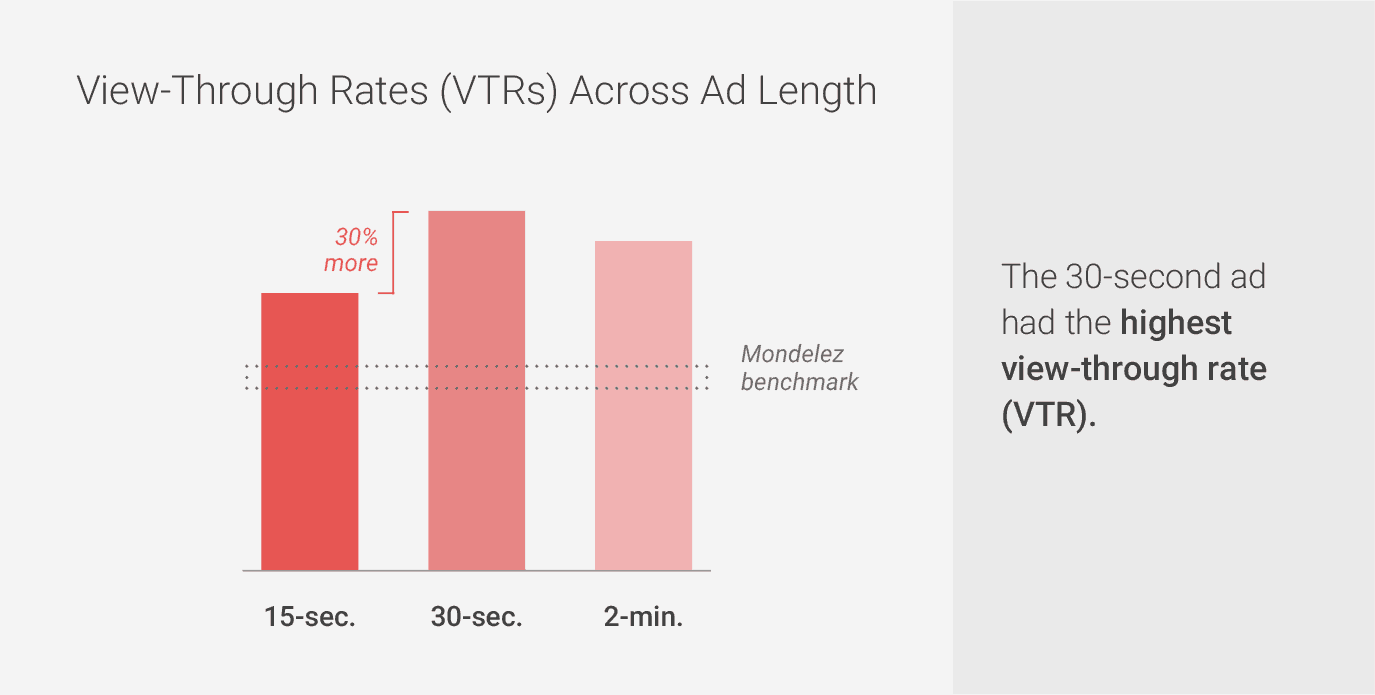
Yet shockingly these longer ads will be discontinued by YouTube next year.
This sends a very clear message and although it may seem contradictory, it makes sense when you consider it from your audience’s perspective.
What works best for advertisers’ results doesn’t always produce happy users. YouTube needs users to enjoy their services otherwise they will abandon it and YouTube will have a smaller and smaller reach. This in turn would be the loss of a great resource for advertisers.
It means sometimes you must consider the long view to truly understand these decisions. Video ads disrupt the users’ ability to watch the videos they want, so video ads must be controlled to prevent mass irritation.
While some users may continue to put up with longer ads and they have better brand affinity, many won’t. Users watching short videos will be discouraged by having to watch longer ads in their videos and this degrades the experience, however very short ads can still convey information and cause only minimal disruption. This is a main reason YouTube introduced six second bumper ads last year.
YouTube is not the only video platform to encourage advertisers to embrace shorter ads for the sake of user satisfaction. Facebook are also about to introduce short 6 second video ads. By actively working to produce short, snappy ads with a clear brand message, advertisers will reach a wider audience. With short ads like bumper ads there is no skipping and less chance of total abandonment by users, so embracing short ad styles is an important lesson.
2) Don’t abandon longer ads
YouTube is determined to push shorter ads but data doesn’t lie. The fact that longer ads do produce stronger brand affinity means that advertisers need to maintain some longer ads, while embracing shorter styles. Fortunately, you can still request non-skippable 15 second ads or use skippable True View ads to create longer form ads. By using a variety of YouTube ad types, advertisers can more effectively reach their audience. Shorter ads will gain more exposure due to less skipping and channel abandonment but longer ads can work on conveying more complex messages with more patient users. These ads styles complement each other and video advertisers should not limit themselves to one format.
3) Get your message across fast
Just having a good spread of ad lengths won’t be enough to beat competitors. To master video PPC advertising it is often beneficial to convey your message fast in all video lengths.
Whether you opt for bumper ads, True View skippable ads or non-skippable ads, the best way to ensure your ad is successful is to get your message across straight away. With bumper ads, this is a necessity as they are only six seconds long but this approach should be carried across to all ad types.
Longer ads allow more to be said but your brand name and the product or service you are promoting should be understood ideally within the first five seconds. This is beneficial because some brand affinity can be won even if some users skip or abandon non-skippable ads.
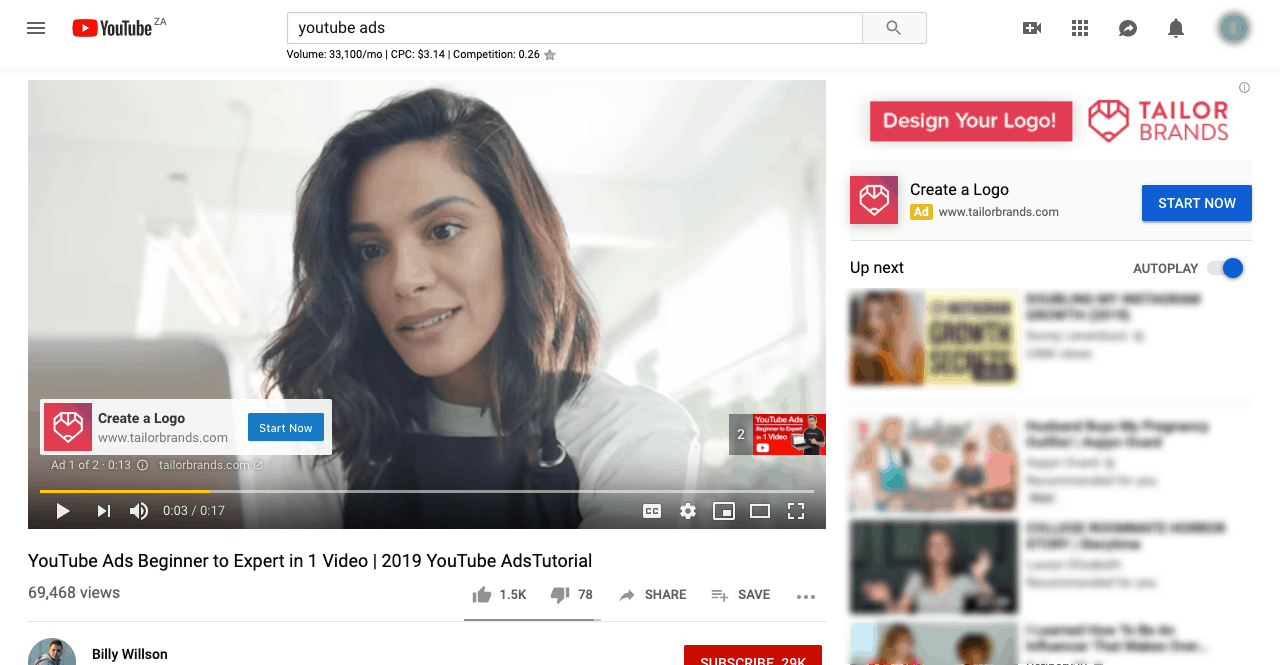
This is also a highly cost-effective way to increase brand affinity with longer True View ads. With True View skippable ads (which are the most popular ads on YouTube), advertisers are only charged if a user watches 30 seconds of an ad or the whole ad if it is under that time at full length. This means if a user skips before the 30 second mark you will not be charged. Given that these ads can be skipped after 5 seconds, many users do exactly that. Advertisers are not charged when users skip after 5 seconds. If you can convey your brand name and core message in the first 5 seconds you will have achieved a degree of brand affinity for free. This will make your company more memorable when that user searches or encounters your business again online.
Savvy video creation like this will encourage maximum exposure for the least cost. Despite longer ads winning on brand affinity, only about 15% of viewers watch the longest video ads all the way through. This means if you fail to mention your brand name or product fast you will throw away huge amounts of brand awareness you could have gained for free.
4) Create intrigue
While gaining brand affinity quickly is a great way to solve the skipping and abandonment issue, ideally you want to progress to creating videos so compelling that users cannot help but watch your whole video.
This can be challenging. Film trailers are among the best examples of video ads that follow the intrigue tactic. Often this can negate getting your message across quickly because it utilises a degree of mystery.
It is entirely possible to get your brand and product name across in the first second and have an unusual intriguing video ad. Having a brand logo and product name appear as the first visual then progress to your intriguing visuals can work but intrigue and mystery do not lend themselves to every industry.
The solution is to choose the tactic that matches your business. Films are a form of entertainment and can afford to use the mysterious intrigue approach but this is harder with products like dishwashers, where you will definitely be better served by focusing on getting the message across in 5 seconds.
If you find that interest from users is still not optimal, you can actually combine and spread these tactics over several video ads.
A good way to create intrigue and buzz is to treat your ads as a sequence, each with their own agenda in serving your overall objective. Try creating a short bumper ad with stunning yet mysterious visuals and audio that create a mystery. In this technique, you don’t reveal your product or service but are merely trying to stimulate curiosity in users. You can have a small handful of these mysterious but attractive ads, with each slightly different, creating yet more curiosity. Try not to over cap your frequency in this approach, as the goal is to be bizarrely memorable until users cannot help but wonder what the ads are all about. Finally use video remarketing to deliver a longer video to those same users which finally reveals your brand and product.
This is an unusual but sometimes effective approach if used correctly. Perfume and makeup industries have often used these mysterious yet evocative visuals at the start of their ads to create curiosity and desire before revealing the product to be sold.
Again, this lends itself to certain products more than others, so be sure when choosing between intrigue and conveying your brand and message fast, that you consider the nature of your product. Entertainment and luxury items can use mystery better than cheaper or more serious items like B2B services.
5) Focus your video on your targeting criteria
Fast messages and mysterious ads can be handy tools but to really convince users to watch your ads and actually take action, you need to make them relevant. If a video ad is relevant to a user, as well as intriguing and not too long, then you have a perfect recipe to make a real connection with your audience.
High relevancy is the best way to cut through user irritation. There are two ways to ensure high relevancy in your targeting criteria for video advertising. The first is to ensure you target the right audience for your business and the second is to target the right channels on YouTube.
You have plenty of choice when it comes to targeting with your PPC advertising on YouTube.
Just like the display network you can target users geographically, demographically and behaviourally. Focusing on locations is easy and takes care of your geographic targeting but demographics and behaviour is where targeting gets really interesting. By using age, gender, income, interests, custom affinity audiences or in market audiences, your videos can reach users who are the most relevant to your campaign. You can reach those in the market for your product or whose profiles match your target market. Video remarketing lets you draw back those who have already expressed an interest and YouTube is introducing even more precise targeting options.
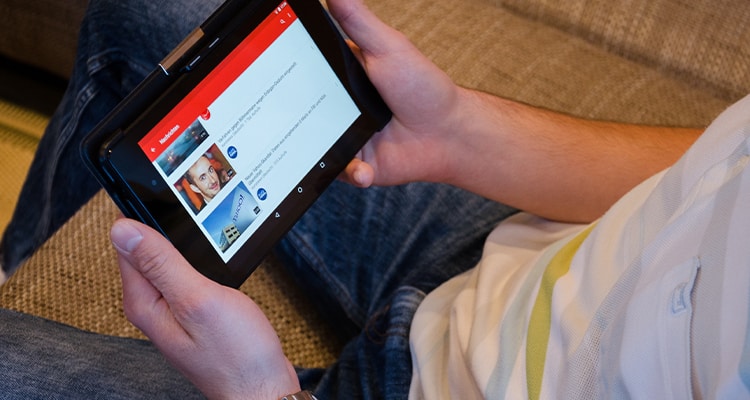
In January 2017, Google announced it would soon allow advertisers to target YouTube video ads to users based on their Google search history. This along with the targeting already possible makes YouTube an even stronger platform for reaching the right audience. Google also revealed it would be making changes to make YouTube ads reach more users on mobile. This is welcome and highly important as over 50% of YouTube traffic is from mobile.
This gives advertisers the power to really filter their audience to the most relevant viewers who are most likely to respond to their ads. Unfortunately, users will often ignore ads even if they are relevant because they are on YouTube to be entertained and don’t want their videos to be interrupted.
This is why, on YouTube, it can be just as important to target the right content as it is the right person. By targeting placements with YouTube video ads, you can control on which channels your videos are seen. This tactic should not be overlooked as it is especially powerful in the case of YouTube videos. If you choose channels relevant to your industry it is more likely that users are watching content similar to your ads already, for example makeup brands targeting beauty blogger channels or SEO software companies targeting SEO strategy webinars. This will make the ad far less jarring and disruptive and increase the chance the video will be watched in full.
Both targeting by audience type and content type can be extremely influential in helping users to actively enjoy ads.
6) Have clear objectives
By keeping your campaign objectives in mind, you will be more easily able to focus on the right metric, whether that is views, clicks, CPV, CPA, conversions, ROI etc.
On YouTube, you can push your products/services, your website or focus on growing subscribers, just accumulating more views or pushing traffic to a specific video for your content marketing.
Different ad types can lend themselves to different objectives. Bumper ads and True View ads are great for brand awareness, while Discovery ads charge on interactions too, so you can encourage clicks to your longer video content.
This two-step method of a Discovery ad can be very effective for using longer organic videos to push traffic back to your website for conversions and with these ads it makes sense to target keywords from YouTube search. These ads are perfect to those new to YouTube, who are used to the techniques of the search and display network and want to push traffic and conversions rather than general brand awareness.
This is why it is always crucial to consider the end purpose of your video ads before choosing an ad style.
7) Utilise segmentation
Proper segmentation is one of the best strategies for achieving good ROI across all Google platforms. Whether you use YouTube, the search network, display network or shopping network, segmentation is a major advantage.
Segmentation allows advertisers to tailor their targeting and ads to different groups. You can segment by device, by audience type, location, keyword intent level, conversion funnel level and more. This should not be forgotten on the YouTube platform. The substance of the video itself should still be tailored for these different attributes, especially audience type and conversion funnel level to provide the best response. Just as with text ads, if the video message is too forceful for high funnel users they will fail or if they are styled for the wrong age group they will have limited appeal. Always plan video content with these elements in mind and create different videos for different groups. Older users may find different visuals and tones more compelling, so don’t forget to A/B test your video ads.
It may seem like obvious advice, especially for those familiar with AdWords strategy, but segmentation is often overlooked in video advertising, as videos typically take more effort and cost to create than text or image ads. This leads to advertisers cutting corners in strategies to save money. In the long run this leads to less effective ads and less potential positive ROI.
8) Be helpful
Having mastered the right video types for your audience, objective and appropriately segmented, you need to make sure your videos are useful. Since users don’t like their entertainment disturbed, your ad should offer something worthwhile to encourage users to interact with your brand.
By developing educational videos, you can solve common problems for users. This is why tutorial videos are so popular. Tutorials are among the most popular kind of videos on YouTube along with gaming walkthroughs and product reviews, all of which teach the user something helpful.
If you are targeting by demographic, interest or even keyword, think about what would be of value or interest to your target market. While shorter videos make good ads, consider the value the video offers, as you can also push traffic to longer organic videos that provide real solutions.
Try to utilise knowledge you have that your users don’t and share it for their benefit. You can even promote this in your short video ads to create intrigue and trust.
9) Make video ads interactive
Those experienced in PPC advertising should remember how important calls to action are in PPC ads. Calls to action give clear instruction to the user and compel them to take the desired action to help your campaign. Video ads are no different and interactive ads create greater engagement and make it much easier for users to convert having seen a video ad.
You have a wealth of choice when it comes to interactive clickable elements, so choosing the right ones can be tricky. Annotations were the original way to add overlays for calls to action and links to your videos, whether ads or organic. However, these did not work well with a mobile experience.
Since then YouTube has added options for end screens and cards, which provide great overlay calls to action which work with mobile.
End screens are a useful way to promote your website, channel or another video at the end of your video. Cards are very similar but can pop up as teaser text overlaid on your video ad throughout its run time, which then opens to a visual thumbnail card when users click. Just like end screens you can add links, other videos or channels in a card to promote interaction. Links used in interactive elements are the best way to drive conversions especially if you reference them in your video to prompt users to click.
While you create video ads in AdWords, they must first be uploaded to YouTube and it is here in the YouTube creative studio where you must add interactive elements like cards and end screens to your video.
Watch the following video on how to add an end screen to your video:
Video
In the following video, you will find instructions for adding a card to your video:
https://www.youtube.com/embed/n8PN9bERmg8
If you are an e-commerce store and running a Google Shopping campaign you can connect video ads with your Merchant Center account to create True View ads for shopping:
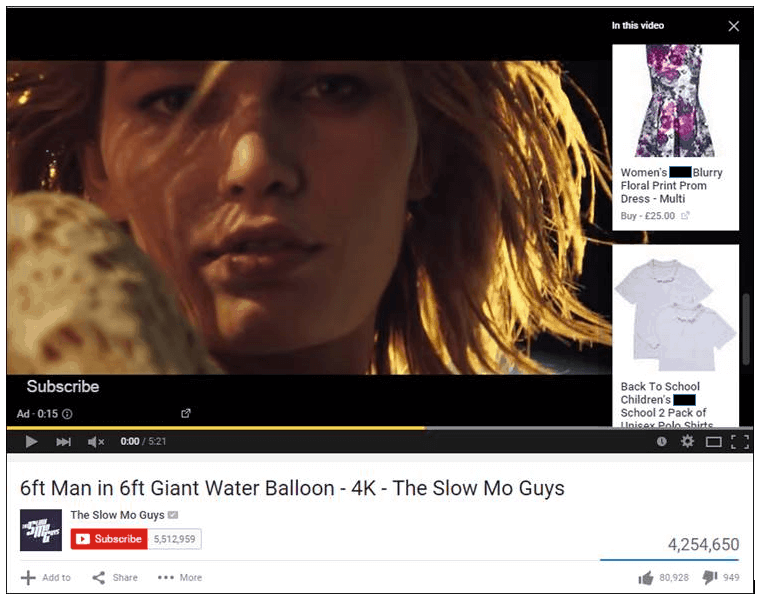
All you need to do is select a new video campaign > Then select shopping as your subtype > Then link to the right Merchant ID
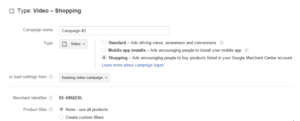
These shopping cards can then appear in your YouTube video ads. They also work with dynamic display remarketing and are one of the most powerful interactive video strategies. Industry leaders Periscopix were able to increase clients’ conversion rates by 40% and decrease CPA by 58% thanks to interactive shopping elements in video ads.
10) Use testimonials
Remember customers are sceptical. Testimonials featured in videos can alleviate some of those worries. Rather than creating whole videos as a testimonial, you can add testimonial quotes as overlays. Unless a user is already researching your product, e.g. an in-market audience targeted video campaign, then they are unlikely to care about a testimonial. However, testimonial overlay quotes in intriguing video ads or longer video content can add a layer of reassurance for your viewers.
11) Make professional videos on YouTube
Advertisers often face the dilemma of paying a professional videographer or making a DIY video.
DIY videos usually look lower quality but they do have their place in your marketing strategies. Professional videos can take longer to make and cost more. This is a barrier to embracing video and using it to interact with your audience regularly.
However, when it comes to YouTube ads you should always go the professional route. Ads are short and they need to impart information quickly. Whether you’re using mystery or speed or high relevancy, beauty helps when it comes to video ads on YouTube. DIY ads can look messy.
Some users will still appreciate DIY videos if they are very helpful but save these for your main YouTube channel content, not your ads, as first impressions are everything. Even DIY organic videos have their downsides, since others in your industry will be less likely to share and embed your unprofessional videos on their sites, therefore DIY videos in general can limit your reach.
DIY video content works far better on Facebook, where live video and social media create a much more casual atmosphere, which is about interacting in the moment. Yet with ads on both platforms this can backfire and ads naturally suit themselves to a polished approach.
12) Actors vs animation?
Both acted videos and animation can be fun in video ads but businesses often mistakenly believe hiring actors will be more expensive. In fact, acted ads are far quicker to create because you simply need to point a camera, whereas animation takes creative skill and far longer to put together. In the long run actors are still cheaper, so consider how much money you need to save on these sophisticated video campaigns.
13) Try using humour
Depending on the product or services you offer, using humorous ads can be especially effective on YouTube. Just as with television, more of your audience use YouTube to be entertained, so they expect more amusing content to grab their attention than they would on the search network or display network. Other emotions can be used as well, like sadness or fear but positive emotions tend to be the most effective in maintaining an optimistic feeling for your brand.
Amusing video ads are better remembered and a less offensive disruption compared to a plain or serious ad, so never underestimate its value. Creating humour can be hard but it is much easier when you have video on your side thanks to the combo of visual moving elements and audio. You could even target your funny video ads to comedy channels using YouTube placements for even greater success.
14) Consistent messages
Whatever tone you decide to use in your video content remember to be consistent. Creating different video ads for different audiences is a powerful strategy but do not confuse users by being too many different things to different people. Stay loyal to your brand identity to ensure a sense of integrity and be genuine. A consistent message and tone is the best way to focus your ad on driving the desired action.
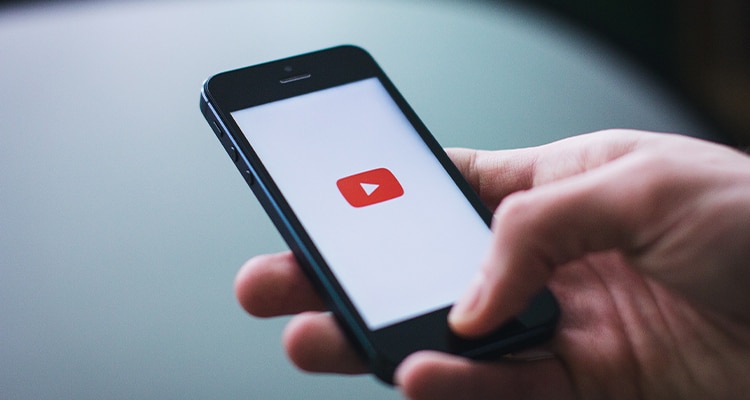
Using intelligent strategies is just as important on YouTube as it is on any other PPC advertising network. This strategy must start at the very beginning when you build your video before creating the ads in AdWords, so always bear your audience and campaign objective in mind when planning video content.
